Mastering Wakesurfing: Techniques and Safety Tips
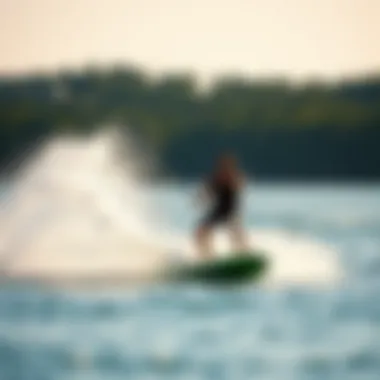
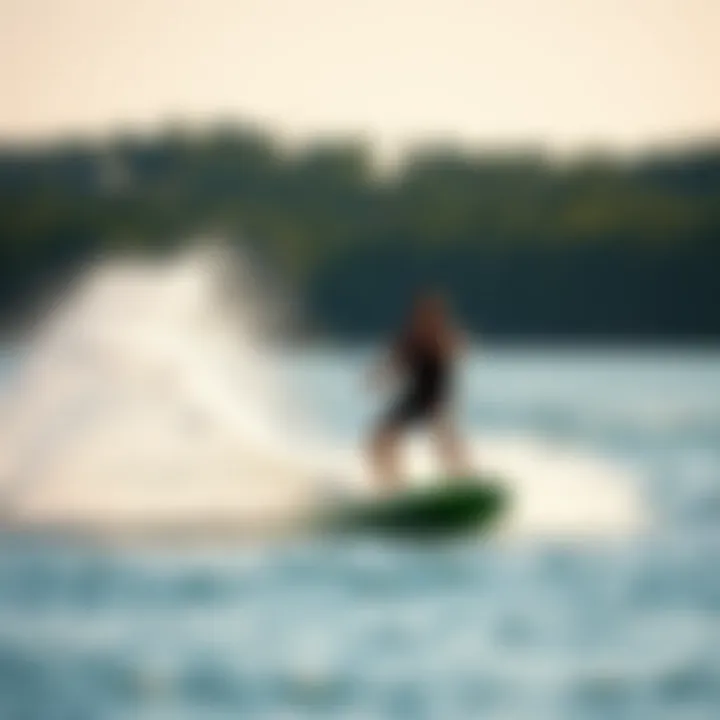
Intro
Wakesurfing has surged in popularity, drawing enthusiasts and adventurers alike to ride the waves generated by boats. Unlike traditional surfing, where you paddle out to catch waves, wakesurfing allows you to enjoy the thrill of gliding behind a vessel, harnessing its wake. It's a blend of balance, agility, and technique that beckons you to dive right in, no matter your background.
Before you take the plunge, understanding the right gear and techniques is vital to ensuring a safe and enjoyable experience. Whether you’re just starting out or fine-tuning your skills, this guide aims to equip you with the knowledge to unlock the full potential of wakesurfing.
Let's start by exploring the Gear and Equipment you'll need to hit the water safely and in style.
Foreword to Wakesurfing
Wakesurfing has become more than just a recreational activity; it’s an art form that combines skill, balance, and a love for water. Understanding the nuances of wakesurfing is crucial for anyone venturing into this sport. It allows surfers to ride the wave created by a boat without being attached by a rope, offering a freedom that traditional surfing cannot replicate. This section aims to lay a solid foundation by defining wakesurfing and tracing its historical roots, paving the way for a deeper understanding in the subsequent sections.
Defining Wakesurfing
At its core, wakesurfing is about riding on a surfboard in the small wave created by a boat, typically driven at slow speeds. Unlike traditional surfing, where you paddle out to catch a wave, wakesurfing involves being towed by a boat initially and then releasing the rope to ride the wake. This sport requires a perfect mix of balance and wave dynamics, often blissfully transforming the wake into a playground for those daring enough.
In wakesurfing, you're not just an athlete; you become one with the water. The positioning of your feet, the way you shift your weight, and even your stance can significantly influence your performance. One minute you are cruising effortlessly, and the next, you are attempting a trick, all while riding the rhythm of the wave.
Historical Context
Tracing the origins of wakesurfing reveals a blend of innovation and passion that began in the late 20th century. Originally, wakesurfing evolved in the early 1990s, spearheaded by surfboard enthusiasts who sought to replicate the thrill of ocean surfing behind boats. The first wakesurf boards were essentially just modified longboards, adapting to the needs of the small wakes created by towboats, which were significant at the time. As technology kicked in, with advancements in boat design and surfboard construction, wakesurfing evolved rapidly.
Over the years, wakesurfing fostered a vibrant culture, attracting enthusiasts to lakes and rivers across the globe. Friends gather for laid-back sessions, and the pure joy experienced on the water made it an instant hit. The sport has grown in popularity, bolstered by community events and competitions showcasing talent and techniques derived from this simple yet addictive pursuit.
These historical snippets not only highlight how far wakesurfing has come but also underline the importance of understanding its roots as we continue to explore its techniques, equipment, and culture. As we delve deeper into the world of wakesurfing, one understands that mastering the art requires not just skill but also a solid grasp of its foundational elements and a respect for its evolution.
Understanding the Equipment
When it comes to wakesurfing, having the right equipment is like having the right toolkit for a handyman. Without it, the task can become frustrating and even dangerous. This section aims to break down the essential components of wakesurfing gear, ensuring you’re fully equipped for an enjoyable and safe experience on the water.
Wakesurfing Boards
Types of Boards
Wakesurfing boards are an essential part of the surf experience. They come in various shapes and sizes, each catering to different styles of surfing. For instance, you might encounter shortboards that are agile and quick, ideal for tricks and fast maneuvers, while longboards offer great stability, perfect for those just starting out or preferring a more relaxed ride.
The key characteristic of these boards lies in their ability to cater to different surfing preferences. The unique feature here is the fin setup; single fins provide control while thruster setups enhance maneuverability. Choosing the right type can significantly affect how you ride the wake, making it an important decision.
Choosing the Right Board
Selecting the appropriate board for your wakesurfing adventure hinges on individual skill level and intended style. Beginners often benefit from wider boards that offer more stability, allowing them to build confidence.
What stands out in this process is understanding volume and weight capacity. A board suited to your weight can improve buoyancy and performance. A misfit board might leave you floundering while trying to gain your balance, which can be frustrating.
Board Maintenance
Taking care of your wakesurf board is just as vital as choosing the right one in the first place. Regular checks for damages and cleaning after each use ensures your investment lasts.
The unique feature of board maintenance involves storing the board away from harsh sunlight and extreme temperatures. A board left out in the sun can deteriorate quickly, affecting its performance. Keep an eye on any dings or scratches as well; these can impact not just performance but safety too.
Tow Boats and Equipment
Characteristics of Suitable Boats
The type of tow boat used can make or break your wakesurfing experience. A suitable boat should feature a direct drive or v-drive system, which helps create the ideal surf wake. Additionally, look for boats with a ballast system that helps adjust the water weight for a fuller wake.
The key characteristic to note is the hull design. A deeper V-shaped hull often creates a cleaner and more powerful wake—essential for experienced surfers looking for bigger tricks. Knowing what to look for in a boat can save a lot of trouble later.
Weight Distribution for Optimal Wakes
Weight distribution is crucial in wakesurfing. Too much weight on one side can distort your wake, making it challenging to ride smoothly. By strategically placing ballast—be it in the bow or stern—you can shape the wake to suit your surf style.
The unique feature of maintaining an optimal weight distribution lies in understanding the balance of the boat. Properly balanced boats ensure a consistent and reliable wake every time you hit the water, which greatly benefits surfers aiming for tricks or those simply wanting a relaxing ride.
Safety Gear
Life Jackets
No wakesurfing outing is complete without the proper safety gear, and life jackets top that list. The key characteristic of life jackets appropriate for wakesurfing is that they allow for freedom of movement while providing flotation. Many jackets are designed for surf-specific activities, offering a snug fit that remains comfortable.
The unique feature of these jackets is that they should be lightweight yet buoyant, ideally made from materials that dry quickly. While it’s easy to throw on any life jacket, selecting one designed for wakesurfing ensures you stay safe and comfortable on the water.
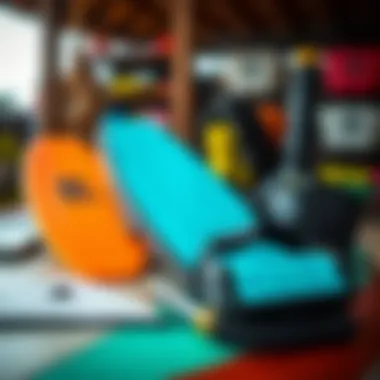
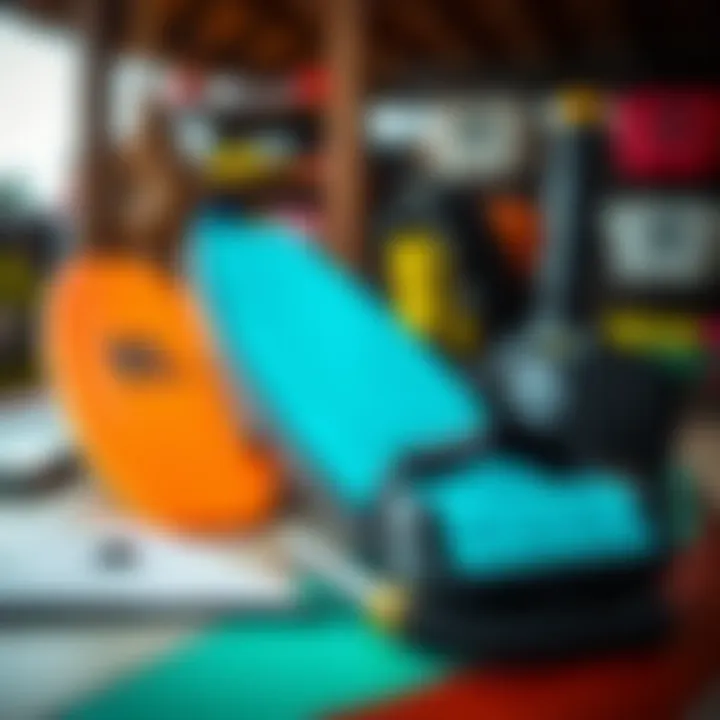
Impact Vests
For those looking to push boundaries and attempt tricks, impact vests are a worthwhile investment. They provide added padding to mitigate the bumps and falls that come with learning new maneuvers.
The key characteristic of impact vests is their design, which blends with your movement, ensuring you can ride freely. They also offer some buoyancy, enhancing safety. However, one downside can be warmth; depending on the conditions, they may be warmer than a standard life jacket.
"When you’re out there shredding the waves, comfort and safety should never take a backseat. A good set of gear can save you from more than just a wet ride."
With these elements in mind, you're better equipped to select the right gear that aligns with your skill and style, enhancing your overall wakesurfing experience.
Techniques for Beginners
Wakesurfing, while exhilarating, can feel a bit daunting if you're just dipping your toes into the water. However, mastering the foundational techniques is crucial for not only having fun but also ensuring safety on the waves. Understanding and practicing these core methods can significantly enhance your experience and boost your confidence. From the initial setup to executing your first ride, each technique builds toward a seamless wake surfing adventure.
Getting Started
Choosing the Right Location
When it comes to wakesurfing, location is everything. Picking a suitable spot sets the stage for a smoother experience. The key characteristic of an ideal location is a calm, open body of water, free from excessive boat traffic or strong currents. Lakes and wide rivers often present the best conditions, as they can provide a consistent wake, which is vital for beginners.
A unique feature of favorable locations is their ability to offer varied terrain. For instance, choosing a spot where the water gradually deepens lets surfers practice safely without fear of hitting the bottom. It’s smart to always scout out the area beforehand, so you know any hazards that could disrupt your fun.
Assessing Water Conditions
Understanding water conditions is another small but crucial cog in the wakesurfing wheel. Each outing should start with a glance at weather patterns—wind speed and direction matter more than you might think. Ideally, a calm day when there's little wind is what you want. It allows for smoother water, making it easier to maintain control.
Rain or storms can stir up the water, creating waves that might be fun for experienced surfers but could spell disaster for beginners. Moreover, wave size and position can also significantly influence your ride experience. Knowing these facts helps to pick not just the right spot but the right time to hit the water.
Basic Stance and Balance
Foot Placement
Foot placement may seem like a mundane factor, but it holds immense sway over your balance and control. The primary principle here is to center your weight over the board. Your back foot should be placed towards the tail while the front foot sits right over or slightly behind the center.
This distribution aids in maneuverability—crucial whether you’re carving through a wave or getting used to just standing on the board. Unfortunately, many beginners overlook this detail, leading to struggles when trying to stay upright. A good rule of thumb is to keep your feet parallel for stability, as it helps to maintain a proper posture throughout.
Body Alignment
Your body alignment comes into play immediately after foot placement. It's essential to keep your knees slightly bent and your back straight. Leaning too far forward or backward can mean trouble, catching you off guard and potentially leading to a tumble.
A key trait of proper alignment is keeping your shoulders aligned with your hips—this balance lets you shift your weight easily without losing control. This approach is especially helpful when you gain speed and momentum. If misalignment occurs, it can quickly derail your balance, resulting in a wipe-out that might shake your confidence.
Starting from the Boat
Towing Techniques
Starting from the boat is often where the magic begins. Understanding towing techniques is critical, as this phase can either set you on a path to success or leave you floundering in the water. The boat should ideally maintain a slow and steady speed, typically around 10 to 12 miles per hour, which allows the surfer to naturally catch the wave’s energy.
One popular technique is the 'slow pull.' This approach gently accelerates to not jerk the surfer off balance and gives them a moment to stabilize after being towed. Good towing not only prevents accidents but also promotes a smoother transition to actual wakesurfing. It’s a collaborative effort between the boat driver and the surfer; clear communication is essential.
Transitioning onto the Board
The transition phase from the boat's pull to being fully engaged on the board can be one of the trickiest elements to master. This often involves moving smoothly from being towed to finding your balance on the board. The common mistake of rushing this transition can lead to falls that might discourage beginners.
A notable feature related to transitioning is the timing. Once you're up and riding behind the boat, there should be a moment where you allow the boat to create a steady wake, then shift your weight forwards slightly while keeping your knees bent. Knowing when to make that shift can significantly affect your riding experience.
In summary, developing these essential techniques can pave the way for a rewarding wakesurfing journey. By focusing on starting basics, you prepare yourself for more advanced moves down the line, extending your time on the water with confidence and enjoyment.
Advanced Wakesurfing Techniques
When it comes to wakesurfing, moving beyond the basics opens the door to a world of exhilarating possibilities. Advanced techniques are not just about flashy moves; they enhance your overall experience on the water. Knowing how to master tricks, maneuvers, and improve flow can elevate both your performance and enjoyment. These skills build confidence, allowing you to explore and push the boundaries of your wakesurfing capabilities. In this section, we dive into the nitty-gritty of advanced wakesurfing, breaking it down into tricks, speed improvement methods, and essential flow techniques.
Tricks and Maneuvers
Prolusion to Tricks
Mastering tricks is like hitting the sweet spot in music. It’s where the rhythm meets creativity, allowing you to express yourself on the water. The introduction of tricks adds a dynamic layer to wakesurfing, making it both thrilling and visually appealing. One of the key characteristics of trick development is innovation; no two surfers tackle a trick the same way. This individuality is what makes wakesurfing a vibrant community, as surfers constantly share their takes on the latest moves.
While some tricks may require a solid foundation in balance and control, many can be adapted to various skill levels. For instance, starting off with simple maneuvers like the 360 spin can be quite rewarding yet challenging. The ability to land these early tricks can boost your confidence tremendously, leading to more complex moves down the road. However, unexpected wipeouts can also happen, so one must be cautious while pushing boundaries.
Additionally, each trick has its own unique feature; whether it’s the wake jump or grab, understanding these elements can help you refine your technique. Learning to celebrate small victories with each successful attempt not only enhances your skills but keeps the spirit of fun alive in your wakesurfing journey.
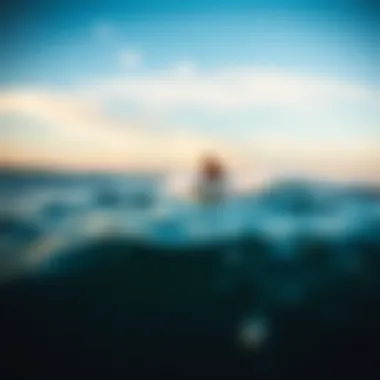
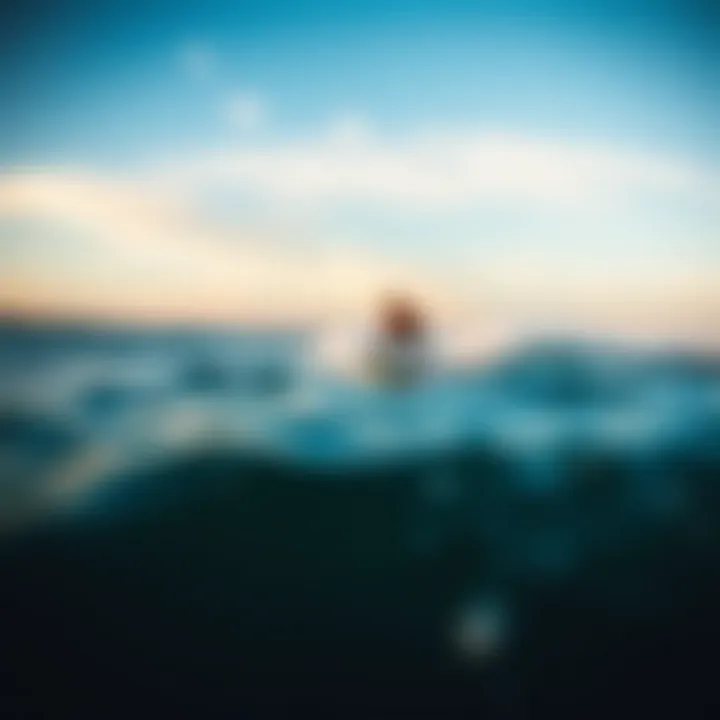
Executing Turns and Spins
Executing turns and spins is where the art of wakesurfing truly comes to life. It’s about harnessing the wave and understanding how to manipulate your body’s weight and balance. The key characteristic of good turns lies in your ability to shift your weight effectively—this helps you carve sharply and maintain speed. A popular feature of well-executed spins is their ability to leave a mark, or splash, creating an impressive visual effect as you glide across the water.
One major advantage of focusing on turns and spins is the sense of freedom it brings. As you master these techniques, you’ll find yourself transitioning seamlessly from one maneuver to the next, creating a fluid performance. However, it can also be a double-edged sword; overconfidence might lead to risky moves that could result in frequent falls. There’s a fine line between being daring and being reckless.
Improving Speed and Flow
Carving Techniques
Carving adds a smooth texture to your wakesurfing that is hard to mimic. This technique allows you to not only maintain speed but also navigate through the waves with grace. The essence of carving centers on edge control and the way you place pressure on your board. This characteristic makes it an essential skill, especially when attempting more complex maneuvers later on.
One of the significant advantages of mastering carving techniques is that it helps you harness the boat's wake better. You'll soon find yourself able to execute tricks rather effortlessly, as your flow improves. If you rely too heavily on flat gliding, you may lose momentum, making it harder to execute subsequent tricks. Carving shapes the way you interact with the wake, ensuring you feel both the power and thrills of the ride.
Weight Shifting
Weight shifting is the heartbeat of wakesurfing and is absolutely critical for mastering advanced techniques. This skill affects how you control your board and create movement. The concept revolves around engaging your core and adjusting your weight to steer the board in a fluid manner. A fundamental characteristic is that it allows you to adapt on the fly—making it a fantastic strategy for both speed and control.
The unique advantage of mastering weight shifting is significant improved maneuverability. You'll find yourself making tighter turns and more responsive adjustments to the shifting waves. However, understanding the balance of weight shifting can take time and practice, as moving too suddenly might throw off your stability. The finer techniques involved in this skill can open up a whole new world, enriching your wakesurfing experience.
Mastering these advanced techniques in wakesurfing not only boosts your skillset but enriches the community as well, inspiring others to push their limits.
Ultimately, delving into advanced wakesurfing techniques encourages a deeper appreciation for the sport, pushing the boundaries for what can be achieved on the water.
Safety Considerations
Safety is not just a word bandied about in conversations about wakesurfing; it is the backbone of an enjoyable experience on the water. Whether you’re beginning your journey or you’ve got some miles under your belt, understanding and prioritizing safety can spell the difference between a fun day out and a regrettable mishap. With the right safety measures, you can not only protect yourself but also contribute to a safe environment for others on the water.
Understanding Water Safety
The heart of water safety lies in awareness. It’s crucial for every wakesurfer to understand the specific risks that come with the territory. Strong currents, changing weather conditions, and deeper waters may pose unforeseen challenges.
- Be Informed: Knowing the body of water and its specific dangers, such as rocks or shallow areas, is essential.
- Assess Conditions: Before you hit the waves, pay attention to wind speed, water temperature, and current strength. These factors play a significant role in ensuring safety.
Like the saying goes, “Better safe than sorry,” and this holds true especially when you’re out on unfamiliar waters. Familiarizing yourself with basic water regulations and respecting fellow surfers can foster a collaborative environment that promotes safety.
Emergency Preparedness
Emergencies can arise without a moment’s notice, making proper preparedness key to a safe day on the water. Creating plans and ensuring effective communication can save lives.
Creating an Emergency Plan
Having an emergency plan isn’t just a prudent choice; it’s a wise investment in your safety. Emergency plans detail steps to take in various scenarios, from equipment failure to personal injury. One of the crucial characteristics of a solid plan is its versatility.
- Define Roles: Know who’s doing what in case of an emergency. This clarity can drastically reduce response time.
- Identify Resources: Make a list of emergency contacts, locations for medical assistance, and even the nearest safe zones. This information should be easily accessible.
By having clear guidance and defining specific actions, everyone on board understands what to do, which minimizes panic and confusion.
Communicating on the Water
Communication is a cornerstone of effective safety measures while wakesurfing. The water can be unpredictable, and while you might be in the moment, ensuring your fellow surfers know your whereabouts and status is crucial.
- Use Signals: Hand signals or whistles can facilitate communication, especially in noisy environments. This is not just a unique feature but a necessity for promoting shared safety.
- Stay Informed: Regularly check in with companions about their comfort levels and any issues they're facing.
Communication establishes a connection, ensuring that everyone on the water has each other’s backs. This kind of established rapport can significantly reduce the risk of accidents, making wakesurfing a more enjoyable and safer experience overall.
While the thrills of wakesurfing are enticing, remember that safety should always take precedence, creating a ride that lasts rather than a memory you’d rather forget.
Environmental Impact of Wakesurfing
Wakesurfing is not merely a thrilling sport; it carries with it significant environmental implications that deserve our attention. The impact we have on the water and the ecosystems surrounding it is profound, and understanding these effects is crucial for both surfers and the broader community. Not only does it help us appreciate the sport more, but it also enables us to engage in practices that protect the very resources we cherish. The discussion around environmentaI impact is vital, as it can shape how we approach wakesurfing, ensuring that our enjoyment doesn’t come at the cost of ecological degradation.
Understanding Wake Effects
The waves we create while wakesurfing don’t just contribute to our sport; they also influence water bodies in ways that can be detrimental if not managed properly. This ripple effect is both figurative and literal.
When a tow boat slices through the water, it generates wakes that can erode shorelines, disturb aquatic habitats, and disrupt the natural behavior of marine life. For instance, the strong wake can scour the bottom of lakes or rivers, impacting plant life and reducing the natural cover that fish rely on. If a large group of wakesurfers congregates in a single location, the cumulative wave action can lead to noticeable shifts in local geography as well.
Furthermore, it’s not just the size and frequency of the wakes that matter; their composition also plays a role. Wakes that strike shallow areas can disturb sediment, releasing nutrients that may trigger harmful algal blooms, which can render water unsafe for both humans and wildlife.
Being aware of these effects can help us take more conscientious approach. For instance, maintaining distance from sensitive shorelines and avoiding low-water conditions can greatly reduce the negative impact of wakesurfing on our environment.
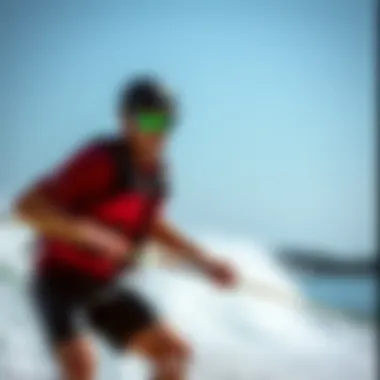
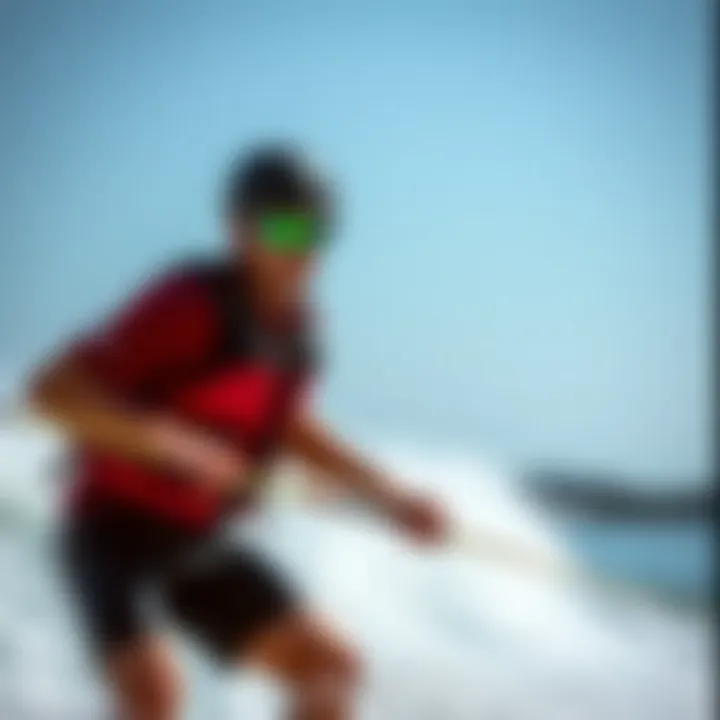
Sustainable Practices
Embracing sustainable practices in wakesurfing is not simply a luxury but rather a necessity if we aim to preserve the beauty of our water environments. Here are a few steps every wakesurfer can take to minimize their ecological footprint:
- Choose Eco-Friendly Boats: Many manufacturers are now developing boats that are designed specifically to minimize their impact on water bodies. These boats can create larger wakes with less fuel consumption, which significantly decreases emissions.
- Utilize Proper Weight Distribution: By ensuring the boat is loaded with ballast in a way that optimizes its performance while reducing wake size, we can limit the wake's negative impacts on shorelines and habitats.
- Limit Group Sizes: Organizing smaller outings rather than large group events helps mitigate wake disturbances. This is especially important in sensitive ecosystems.
- Educate and Advocate: Sharing knowledge about the environmental aspects of wakesurfing with fellow enthusiasts fosters a culture of care. Encourage peers to participate in clean-up initiatives and to respect local guidelines.
"A small act of caring can have a significant impact on our waters. Each wake we create should ripple with respect for the environment."
By embracing these practices, we not only enhance our wakesurfing experience but also ensure that we are stewards of the waterways we love.
The Culture of Wakesurfing
Wakesurfing is more than just a sport; it's an experience that melds community, passion, and lifestyle. This culture enriches the wakesurfing experience, inviting enthusiasts to be part of something greater than themselves. The bonds formed on the water, the joy of sharing techniques, and the collective pursuit of adventure create a vibrant tapestry of human connection. This section dives into the essential components of the wakesurfing community, exploring the events that bring people together and the notable figures that inspire us all.
Community and Events
Competitions
Competitions in wakesurfing are platforms where skill meets artistry. They showcase the prowess of athletes, offering a thrilling spectacle for spectators and participants alike. One key characteristic of these competitions is the focus on creativity and style rather than just technical execution. This is particularly appealing because it encourages surfers to push boundaries, achieving new tricks and showcasing individuality.
The benefits of participating in competitions include exposure, community acknowledgment, and the opportunity to learn from peers. Competing not only hones one's skills but also fosters camaraderie among surfers.
However, there can be downsides to competitions. The pressure to perform and the competitive atmosphere might discourage novice participants from embracing the fun aspects of wakesurfing. Still, the unique feature of competitions – the chance to connect with top-notch athletes and enthusiasts – tends to outweigh these concerns, making participation a worthwhile endeavor for many.
Local Gatherings
Local gatherings are the soul of the wakesurfing culture. They represent informal meet-ups where surfers from all skill levels come together to share experiences, tips, and stories on the water. A key characteristic of these gatherings is their laid-back nature, which promotes an inclusive environment that welcomes everyone. Such settings encourage novices to learn from more seasoned surfers without the intimidation often felt in competitive arenas.
One benefit of local gatherings is their role in strengthening community ties. Friends are made, and networks formed which can lead to lifelong relationships and unforgettable memories. Unique to these events is the spontaneous exchange of knowledge, where seasoned surfers freely share their skills with amateurs, creating an enriching atmosphere.
On the flip side, local gatherings can sometimes lack structure, which might deter those who prefer more organized environments. Depending on location and availability, participation can vary, but the overall sense of community remains a strong draw.
Notable Wakesurfers
Famed wakesurfers often serve as icons within the community, inspiring the next generation of surfers. Their journeys reflect dedication, perseverance, and love for the sport – qualities that resonate with enthusiasts. Notable figures might include athletes known for their groundbreaking tricks or contributions to the growth of wakesurfing.
Such athletes highlight not only the physical skill needed to excel but also the mindset required to overcome challenges. By showcasing their achievements, they illuminate the paths for newcomers while fostering the culture of mentorship and support that defines wakesurfing.
Wakesurfing Destinations
Wakesurfing isn’t just a sport; it’s a lifestyle that thrives on the thrill of catching the perfect wave behind a boat. One of the unsung heroes of mastering this art is knowing where to do it. The right location can enhance your experience manifold, influencing everything from wave quality to safety and community. Choosing the right destination means considering various factors — the type of wakesurfing you prefer, the local culture, and even the seasonality of the water.
Whether you're a seasoned pro or a newbie just paddling out, having a go-to list of spots can elevate your wakesurfing game. Imagine carving through clear waters against a backdrop of stunning scenery or joining a jovial community of surf enthusiasts sharing tips and tales on the shore. Let’s break it down further.
Top Locations
When it comes to wakesurfing, certain locations consistently stand out for their ideal conditions. Here are a few must-visit spots that cater to various skill levels:
- Lake Powell, Arizona & Utah: A breathtaking spot surrounded by red rock formations. The water is often glassy and perfect for beginners and experienced surfers alike. Plus, you can explore over 2,000 miles of shoreline.
- Lake Tahoe, California & Nevada: Known for its clear blue waters and stunning mountain views. It offers a variety of conditions for wakesurfing and a vibrant local culture.
- The Florida Keys: Featuring warm waters and a mix of calm bays and open ocean, it’s a premier location for wakesurfers looking to chase the ultimate thrill.
- Lake Lanier, Georgia: Easily accessible from Atlanta, it attracts a lively community. The water here can get quite crowded, but the vibe is electric.
- Texas Hill Country: Here, the rivers are often less crowded, giving a more laid-back atmosphere. Great for those who prefer intimate surf sessions.
Each of these locations holds its own unique charm and set of challenges, making them perfect for anyone looking to enjoy the sport and meet like-minded folks.
Best Conditions for Wakesurfing
The conditions of the water can significantly affect your wakesurfing experience. Here are some key elements to keep in mind:
- Water Temperature: Ideally, you want warm water that’s comfortable to spend hours in. It keeps the experience enjoyable and reduces the need for bulky wetsuits.
- Wave Size: Different skill levels prefer varying wave heights. Beginners often favor smaller, more manageable wakes while advanced surfers may seek out larger, more intense waves.
- Wind Conditions: Look for days when the wind is calm. Wind can create choppy waters, making it harder to surf effectively and safely.
- Time of Day: Early mornings or late afternoons typically yield the best conditions. The water tends to be calmer with fewer boats, allowing for smoother rides.
- Drought Season Consideration: Be wise to seasons when water levels are low. Some lakes may not be suitable for wakesurfing if they’re too shallow.
Understanding these conditions can make a world of difference in your overall enjoyment and safety while wakesurfing. Use this knowledge to plan your trips wisely, ensuring every surf session is as perfect as can be.
"Wakesurfing isn’t just a sport; it’s a connection with nature and an adventure shared with friends and family."
With all these points in mind, you’re well on your way to not just mastering your technique but also setting out to explore the best wakesurfing destinations the world has to offer. The water is waiting; dive into adventure with an informed choice of where to surf!
The End
Wrapping things up in the realm of wakesurfing reveals not just a sport, but an adventure that brings together skill, community, and respect for our waters. This article aimed to disentangle the various threads that contribute to mastering this exciting discipline. From the fundamentals of equipment such as wakesurfing boards and tow boats to advanced techniques and safety measures, the journey educates surfers of all levels.
Summary of Key Points
- Understanding Equipment: The significance of choosing the right board and excellent tow boat can’t be overstated. Tailoring equipment to personal skill level and water conditions can make or break the experience.
- Techniques for All Levels: Techniques range from beginner essentials to advanced tricks, emphasizing that continuous learning keeps the sport fresh and exciting. Starting with the right stance and balancing can lead to impressive maneuvers down the line.
- Safety is Paramount: Knowledge of safety gear and emergency preparedness can enhance not only individual surfer’s experience but also that of the whole crew on the water.
- Environmental Awareness: Recognizing the ecological impacts of wakesurfing allows surfers to act responsibly. Sustainable practices should be a priority for anyone enjoying water activities.
- Community and Culture: Acknowledging the vibrant community surrounding wakesurfing adds depth to the sport; it's about sharing experiences and camaraderie, whether in competitions or local meet-ups.
Future of Wakesurfing
Looking ahead, the future of wakesurfing is promising. The ongoing evolution of technology will likely lead to improved equipment, making it safer and more accessible. We may also see an increase in environmentally conscious practices as awareness of aquatic ecosystems grows.
Social media platforms and online communities are driving expansion in the sport, and with increases in participation, events like competitions and local gatherings will become more prevalent. Furthermore, with more recreational areas being developed, opportunities to practice will multiply, ensuring that wakesurfing continues to attract enthusiasts.
All in all, as we stand at the cusp of this adrenaline-fueled journey, the possibilities appear limitless. With the right knowledge, respect for the environment, and a sense of community, the art of wakesurfing is destined to flourish for years to come.







